
Addressing the Recent Lag Issue in Microsoft’s Read Aloud Feature
In the ever-evolving world of technology, even the most reliable tools can sometimes hit a snag. Microsoft’s Read Aloud feature, a crucial tool for many users seeking an accessible reading experience, has recently been experiencing a noticeable lag. This delay occurs between initiating the read-aloud function and while transitioning between paragraphs, affecting the seamless experience users have come to expect.
Understanding the Read Aloud Feature
Microsoft’s Read Aloud feature is part of the company’s suite of accessibility tools, integrated into various products such as Microsoft Edge, Word, and Outlook. This functionality is designed to assist users by converting text to speech, making written content accessible to individuals with visual impairments, reading difficulties, or those who simply prefer auditory learning.
The Emerging Issue
Over the past few weeks, numerous users have reported a significant lag when using the Read Aloud feature. The delays manifest in two primary ways:
Start-Up Lag:
A noticeable pause between clicking the read-aloud button and the feature starting to read the text.
Paragraph Transition Lag:
An interruption or delay when moving from one paragraph to the next, breaking the flow of the reading experience.
Impact on Users
This lag can be particularly disruptive for users who rely on this feature for continuous and smooth content consumption. It can hinder productivity, especially for those who use the tool for lengthy documents or continuous reading sessions. For individuals with disabilities, such interruptions can be more than just an inconvenience; they can significantly impact the usability of the software.
Potential Causes
While Microsoft has not yet provided an official statement regarding the root cause of these lags, several potential factors could be contributing to the issue:
Software Updates:
Recent updates to the operating system or the application itself might have inadvertently introduced bugs.
Server Issues:
Since some read-aloud functionalities may depend on cloud services, server-side issues could be causing delays.
Local Device Performance:
Older or less powerful devices might struggle with the processing demands of the feature, particularly after updates that increase resource requirements.
Internet Connectivity:
For cloud-dependent functionalities, poor internet connections could lead to increased latency.
Temporary Workaround: Changing the Default Voice
One workaround that users have found effective is changing the default voice used by the Read Aloud feature. This adjustment seems to mitigate the lag issues for many:
1. Access Voice Settings**: Go to the settings of the application where you are using the Read Aloud feature.
2. Change the Voice**: Select a different voice from the available options, avoiding the default one.
3. Test the Feature**: Start the Read Aloud function again to see if the lag issue persists.
Additional Workarounds
In addition to changing the voice, users can try a few other workarounds to mitigate the issue:
Check for Updates:
Ensure that both the operating system and the Microsoft applications are up-to-date. Sometimes, subsequent patches are released quickly to fix such issues.
Reinstall the Application:
Uninstalling and reinstalling the affected application might resolve any corrupt files or settings.
Use Offline Versions:
If the lag is related to internet connectivity, downloading documents for offline use might help improve performance.
Optimize Device Performance**: Close unnecessary applications and processes to free up system resources.
Looking Ahead
Microsoft is known for its commitment to improving accessibility and user experience across its products. It’s likely that the company is already working on identifying and resolving the issues causing the lag in the Read Aloud feature. In the meantime, the community can provide feedback and support through official channels to ensure that the problem is addressed promptly.
The recent lag issues in Microsoft’s Read Aloud feature highlight the challenges that even well-established tech companies can face in maintaining seamless user experiences. While these disruptions are frustrating, they also serve as a reminder of the importance of continuous feedback and improvement in technology. As Microsoft works towards a solution, users can employ temporary workarounds, such as changing the default voice, to alleviate some of the inconvenience. We anticipate a swift resolution from Microsoft, ensuring that the Read Aloud feature continues to be a reliable tool for accessibility and productivity.
